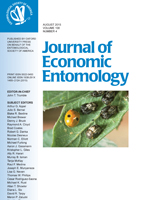This laboratory-based study examined the effects of low-temperature phosphine fumigation on the survival of the eggs and larvae of the guava fruit fly, Bactrocera correcta (Bezzi). Individual flies at different developmental stages, from 6-h-old eggs to third instars, were exposed to 0.92 mg/liter phosphine for 1–7 d at 5°C. We found that 12-h-old eggs and third instars were the most tolerant to phosphine. Increasing phosphine concentrations from 0.46 to 4.56 mg/liter increased mortality in these two stages. However, increased exposure times were required to achieve equal mortality rates in 12-h-old eggs and third instars when phosphine concentrations were ≥4.56 and ≥3.65 mg/liter, respectively. Cnt = k expression was obtained at 50, 90, and 99% mortality levels, and the toxicity index (n) ranged from 0.43 to 0.77 for the two stages. The synergistic effects of a controlled atmosphere (CA) with elevated CO2 levels were also investigated, and we found that a CO2 concentration between 10% and 15% under CA conditions was optimal for low-temperature phosphine fumigation.
How to translate text using browser tools
1 August 2015
Effect of Low-Temperature Phosphine Fumigation on the Survival of Bactrocera correcta (Diptera: Tephritidae)
Tao Liu,
Li Li,
Fanhua Zhang,
Shaorun Gong,
Tianxiu Li,
Guoping Zhan,
Yuejin Wang
ACCESS THE FULL ARTICLE
It is not available for individual sale.
This article is only available to subscribers.
It is not available for individual sale.
It is not available for individual sale.

Journal of Economic Entomology
Vol. 108 • No. 4
August 2015
Vol. 108 • No. 4
August 2015
Bactrocera correcta
exposure time
mortality
phosphine
synergistic effect




